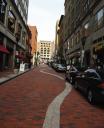By Joe Tarzi ’08
Hartford is located directly between Massachusetts’ capital of Boston and New York State’s de-facto capital New York City. Hartford is often seen by outsiders as little more than a rest-stop between Boston, an important regional center, and New York, a city that many (including myself) argue is the center of the developed world. It is certainly easy to see why this image prevails among outsiders, while Manhattan has two central business districts, downtown and midtown, stretching about four miles from Battery Park to Central Park, Hartford’s downtown lasts for about four or five blocks in any direction. Where Boston and New York have sophisticated subway systems Greater Hartford (as the city and its suburbs are known) has only an underfunded, difficult to navigate bus system. Where New York has Broadway’s theaters, Hartford has the Bushnell Theater and several smaller performing arts centers. The comparisons could, of course, go on.
Hartford surprisingly manages to hold its own against its neighbors in some cases however. The city, for example, is home to seven Fortune 500 companies while Boston is home to eight. Also, while Boston is suspected to be coming to the end of a large boom, Hartford is just starting a boom after a decade and a half of bust. The first skyscraper since the late 1980s was recently built downtown. That building, Hartford 21, is also the tallest residential tower in New England and the fourth tallest building in the city.
Hartford currently is branded with a reputation in New England that many throughout the nation associated with New York City in the 1970s and 1980s: the city is dangerous. The reputation is, in some cases, founded in fact. The homicide rate in Hartford is in league with cities such as Washington, Baltimore, Rochester and Atlanta with about 35 homicides per 100,000 people; New York hovers at about 8 homicides per 100,000 people. Despite this statistic, most murders in Hartford occur far from Trinity in the city’s North End and premeditated due to disputes over drugs or other illegal activities.
Downtown Hartford does not usually suffer from the same reputation as many of Hartford’s neighborhoods. The Downtown, or the central business district (CBD), is one of the most important business centers in the state and is quickly becoming a popular social destination in central Connecticut. The safety situation in the CBD is comparable to that of central Boston and Midtown Manhattan. The CBD is also the center of Hartford’s picturesque skyline which is, arguably, unparallel in New England. One of Hartford’s most distinctive buildings, the Travelers Tower, now the second tallest building in the city sporting a distinctive beacon at the top, was the first commercial building outside of Manhattan to rise higher than 500 feet. Unfortunately, Downtown Hartford, in stark contrast to both Boston and New York, lacks significant retail development. Downtown long had a reputation for rolling up its sidewalks at 5 p.m. but with recent development such as the aforementioned Hartford 21 tower and the new Connecticut Convention Center retail is slowly returning to the center of the city.
At only 17 square miles Hartford is also one of the smallest cities by geographic size in the country. Boston by contrast is about 50 square miles and New York is a whopping 300 square miles. One could walk the three miles from Downtown to the West Hartford border along Asylum Avenue in less than an hour. This is a result of the provincial nature of most towns in New England. Where New York was able to annex the boroughs of Queens, Brooklyn, The Bronx, and Staten Island long ago, Hartford has been unsuccessful in even annexing the parkland it owns in adjacent towns. The towns surrounding Hartford, particularly affluent West Hartford, have continuously dismissed the cities usually futile efforts at annexation. The disparity between towns in Connecticut is amplified by the fact that the state lacks any form of county government, counties existing in name only. This lack of a regional government, some believe, contributes to the decline of cities and rise of suburbs (and sprawl) in Connecticut.
Rather than Boston or New York, Hartford is more comparable to other New England cities like Providence or New Haven. The plain and simple fact is that with the exception of Boston and Stamford, which is essentially a New York suburb, most New England cities have seen better days. Hartford is similar in predicament to Springfield, Mass. and Waterbury, Conn. Both were former centers of industry that have fallen on hard times. Hartford generally falls in between depressed Springfield and revitalizing cities such as New Haven and Providence.
Hartford would never be mistaken for New York or even Boston. Rather, it is more typical of most American cities. Like Boston and New York, Hartford defiantly has its problems and its advantages. The city has been going through growing and shrinking pains throughout the twentieth century. At the turn of the century, however, things are looking up and billions of dollars are pouring into downtown along with thousands of convention goers in town for events at the new Connecticut Convention Center. New retail space sprouting up around Bushnell Park and along Trumbull Street is also good news.

